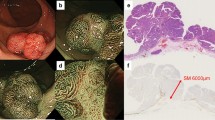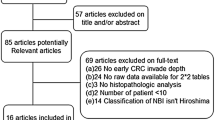Abstract
Background
Endoscopic resection (ER) is widely applied to treat early colorectal cancer (CRC). Predicting the invasion depth of early CRC is critical in determining treatment strategies. The use of computer-aided diagnosis (CAD) algorithms could theoretically make accurate and objective predictions regarding the suitability of lesions for ER indication based on invasion depth. This study aimed to assess diagnostic test accuracy of CAD algorithms in predicting the invasion depth of early CRC and to compare the performance between the CAD algorithms and endoscopists.
Methods
Multiple databases were searched until June 30, 2022 for studies that evaluated the diagnostic performance of CAD algorithms for invasion depth of CRC. Meta-analysis of diagnostic test accuracy using a bivariate mixed-effects model was performed.
Results
Ten studies consisting of 13 arms (13,918 images from 1472 lesions) were included. Due to significant heterogeneity, studies were stratified into Japan/Korea-based or China-based studies. For the former, the area under the curve (AUC), sensitivity, and specificity of the CAD algorithms were 0.89 (95% CI 0.86–0.91), 62% (95% CI 50–72%), and 96% (95% CI 93–98%), respectively. For the latter, AUC, sensitivity, and specificity were 0.94 (95% CI 0.92–0.96), 88% (95% CI 78–94%), and 88% (95% CI 80–93%), respectively. The performance of the CAD algorithms in Japan/Korea-based studies was not significantly different from that of all endoscopists (0.88 vs. 0.91, P = 0.10) but was inferior to that of expert endoscopists (0.88 vs. 0.92, P = 0.03). The performance of the CAD algorithms in China-based studies was better than that of all endoscopists (0.94 vs. 0.90, P = 0.01).
Conclusion
The CAD algorithms showed comparable accuracy for prediction of invasion depth of early CRC compared to all endoscopists, which was still lower than expert endoscopists in diagnostic accuracy; more improvements should be achieved before it can be extensively applied to clinical practice.






Similar content being viewed by others
Abbreviations
- AUC:
-
Area under the curve
- CAD:
-
Computer-aided diagnosis
- CI:
-
Confidence interval
- CRC:
-
Colorectal cancer
- DOR:
-
Diagnostic odds ratio
- FN:
-
False negative
- FP:
-
False positive
- IEE:
-
Image-enhanced endoscopy
- JNET:
-
Japan NBI Expert Team
- ME-NBI:
-
Magnifying endoscopy with narrow-band imaging
- NBI:
-
Narrow-band imaging
- NICE:
-
NBI international colorectal endoscopic
- NLR:
-
Negative likelihood ratio
- PLR:
-
Positive likelihood ratio
- SM:
-
Submucosa
- TN:
-
True negative
- TP:
-
True positive
- WLI:
-
White-light imaging
References
Sung H, Ferlay J, Siegel RL, Laversanne M, Soerjomataram I, Jemal A, Bray F (2021) Global cancer statistics 2020: GLOBOCAN estimates of incidence and mortality worldwide for 36 cancers in 185 countries. CA Cancer J Clin 71:209–249
Arnold M, Sierra MS, Laversanne M, Soerjomataram I, Jemal A, Bray F (2017) Global patterns and trends in colorectal cancer incidence and mortality. Gut 66:683–691
Nishihara R, Wu K, Lochhead P, Morikawa T, Liao X, Qian ZR, Inamura K, Kim SA, Kuchiba A, Yamauchi M, Imamura Y, Willett WC, Rosner BA, Fuchs CS, Giovannucci E, Ogino S, Chan AT (2013) Long-term colorectal-cancer incidence and mortality after lower endoscopy. N Engl J Med 369:1095–1105
Kanth P, Inadomi JM (2021) Screening and prevention of colorectal cancer. BMJ 374:n1855
Levin TR, Corley DA, Jensen CD, Schottinger JE, Quinn VP, Zauber AG, Lee JK, Zhao WK, Udaltsova N, Ghai NR, Lee AT, Quesenberry CP, Fireman BH, Doubeni CA (2018) Effects of organized colorectal cancer screening on cancer incidence and mortality in a large community-based population. Gastroenterology 155:1383-1391.e1385
Kaltenbach T, Anderson JC, Burke CA, Dominitz JA, Gupta S, Lieberman D, Robertson DJ, Shaukat A, Syngal S, Rex DK (2020) Endoscopic removal of colorectal lesions-recommendations by the US multi-society task force on colorectal cancer. Gastrointest Endosc 91:486–519
Pimentel-Nunes P, Libânio D, Bastiaansen BAJ, Bhandari P, Bisschops R, Bourke MJ, Esposito G, Lemmers A, Maselli R, Messmann H, Pech O, Pioche M, Vieth M, Weusten B, van Hooft JE, Deprez PH, Dinis-Ribeiro M (2022) Endoscopic submucosal dissection for superficial gastrointestinal lesions: European Society of Gastrointestinal Endoscopy (ESGE) guideline—update 2022. Endoscopy 54:591–622
Tanaka S, Kashida H, Saito Y, Yahagi N, Yamano H, Saito S, Hisabe T, Yao T, Watanabe M, Yoshida M, Saitoh Y, Tsuruta O, Sugihara KI, Igarashi M, Toyonaga T, Ajioka Y, Kusunoki M, Koike K, Fujimoto K, Tajiri H (2020) Japan gastroenterological endoscopy society guidelines for colorectal endoscopic submucosal dissection/endoscopic mucosal resection. Dig Endosc 32:219–239
Niimi K, Fujishiro M, Kodashima S, Goto O, Ono S, Hirano K, Minatsuki C, Yamamichi N, Koike K (2010) Long-term outcomes of endoscopic submucosal dissection for colorectal epithelial neoplasms. Endoscopy 42:723–729
Saito Y, Uraoka T, Yamaguchi Y, Hotta K, Sakamoto N, Ikematsu H, Fukuzawa M, Kobayashi N, Nasu J, Michida T, Yoshida S, Ikehara H, Otake Y, Nakajima T, Matsuda T, Saito D (2010) A prospective, multicenter study of 1111 colorectal endoscopic submucosal dissections (with video). Gastrointest Endosc 72:1217–1225
Ikehara H, Saito Y, Matsuda T, Uraoka T, Murakami Y (2010) Diagnosis of depth of invasion for early colorectal cancer using magnifying colonoscopy. J Gastroenterol Hepatol 25:905–912
Matsuda T, Fujii T, Saito Y, Nakajima T, Uraoka T, Kobayashi N, Ikehara H, Ikematsu H, Fu KI, Emura F, Ono A, Sano Y, Shimoda T, Fujimori T (2008) Efficacy of the invasive/non-invasive pattern by magnifying chromoendoscopy to estimate the depth of invasion of early colorectal neoplasms. Am J Gastroenterol 103:2700–2706
Hayashi N, Tanaka S, Hewett DG, Kaltenbach TR, Sano Y, Ponchon T, Saunders BP, Rex DK, Soetikno RM (2013) Endoscopic prediction of deep submucosal invasive carcinoma: validation of the narrow-band imaging international colorectal endoscopic (NICE) classification. Gastrointest Endosc 78:625–632
Sano Y, Hirata D, Saito Y (2018) Japan NBI expert team classification: narrow-band imaging magnifying endoscopic classification of colorectal tumors. Dig Endosc 30:543–545
Katagiri A, Fu KI, Sano Y, Ikematsu H, Horimatsu T, Kaneko K, Muto M, Yoshida S (2008) Narrow band imaging with magnifying colonoscopy as diagnostic tool for predicting histology of early colorectal neoplasia. Aliment Pharmacol Ther 27:1269–1274
Uraoka T, Saito Y, Ikematsu H, Yamamoto K, Sano Y (2011) Sano’s capillary pattern classification for narrow-band imaging of early colorectal lesions. Dig Endosc 23(Suppl 1):112–115
Singh R, Jayanna M, Navadgi S, Ruszkiewicz A, Saito Y, Uedo N (2013) Narrow-band imaging with dual focus magnification in differentiating colorectal neoplasia. Dig Endosc 25(Suppl 2):16–20
Le Berre C, Sandborn WJ, Aridhi S, Devignes MD, Fournier L, Smaïl-Tabbone M, Danese S, Peyrin-Biroulet L (2020) Application of artificial intelligence to gastroenterology and hepatology. Gastroenterology 158:76-94.e72
Taghiakbari M, Mori Y, von Renteln D (2021) Artificial intelligence-assisted colonoscopy: a review of current state of practice and research. World J Gastroenterol 27:8103–8122
Pannala R, Krishnan K, Melson J, Parsi MA, Schulman AR, Sullivan S, Trikudanathan G, Trindade AJ, Watson RR, Maple JT, Lichtenstein DR (2020) Artificial intelligence in gastrointestinal endoscopy. VideoGIE 5:598–613
Okagawa Y, Abe S, Yamada M, Oda I, Saito Y (2022) Artificial intelligence in endoscopy. Dig Dis Sci 67:1553–1572
Yu C, Helwig EJ (2022) The role of AI technology in prediction, diagnosis and treatment of colorectal cancer. Artif Intell Rev 55:323–343
Spadaccini M, Iannone A, Maselli R, Badalamenti M, Desai M, Chandrasekar VT, Patel HK, Fugazza A, Pellegatta G, Galtieri PA, Lollo G, Carrara S, Anderloni A, Rex DK, Savevski V, Wallace MB, Bhandari P, Roesch T, Gralnek IM, Sharma P, Hassan C, Repici A (2021) Computer-aided detection versus advanced imaging for detection of colorectal neoplasia: a systematic review and network meta-analysis. Lancet Gastroenterol Hepatol 6:793–802
Lui TKL, Guo CG, Leung WK (2020) Accuracy of artificial intelligence on histology prediction and detection of colorectal polyps: a systematic review and meta-analysis. Gastrointest Endosc 92:11-22.e16
McInnes MDF, Moher D, Thombs BD, McGrath TA, Bossuyt PM, Clifford T, Cohen JF, Deeks JJ, Gatsonis C, Hooft L, Hunt HA, Hyde CJ, Korevaar DA, Leeflang MMG, Macaskill P, Reitsma JB, Rodin R, Rutjes AWS, Salameh JP, Stevens A, Takwoingi Y, Tonelli M, Weeks L, Whiting P, Willis BH (2018) Preferred reporting items for a systematic review and meta-analysis of diagnostic test accuracy studies: the PRISMA-DTA statement. JAMA 319:388–396
Fagan TJ (1975) Letter: nomogram for Bayes theorem. N Engl J Med 293:257
Li J, Fine JP, Safdar N (2007) Prevalence-dependent diagnostic accuracy measures. Stat Med 26:3258–3273
Altman DG, Bland JM (2003) Interaction revisited: the difference between two estimates. BMJ 326:219
Devillé WL, Buntinx F, Bouter LM, Montori VM, de Vet HC, van der Windt DA, Bezemer PD (2002) Conducting systematic reviews of diagnostic studies: didactic guidelines. BMC Med Res Methodol 2:9
Higgins JP, Thompson SG, Deeks JJ, Altman DG (2003) Measuring inconsistency in meta-analyses. BMJ 327:557–560
Okamoto Y, Yoshida S, Izakura S, Katayama D, Michida R, Koide T, Tamaki T, Kamigaichi Y, Tamari H, Shimohara Y, Nishimura T, Inagaki K, Tanaka H, Yamashita K, Sumimoto K, Oka S, Tanaka S (2022) Development of multi-class computer-aided diagnostic systems using the NICE/JNET classifications for colorectal lesions. J Gastroenterol Hepatol 37:104–110
Tokunaga M, Matsumura T, Nankinzan R, Suzuki T, Oura H, Kaneko T, Fujie M, Hirai S, Saiki R, Akizue N, Okimoto K, Arai M, Kato J, Kato N (2021) Computer-aided diagnosis system using only white-light endoscopy for the prediction of invasion depth in colorectal cancer. Gastrointest Endosc 93:647–653
Luo X, Wang J, Han Z, Yu Y, Chen Z, Huang F, Xu Y, Cai J, Zhang Q, Qiao W, Ng IC, Tan RT, Liu S, Yu H (2021) Artificial intelligence-enhanced white-light colonoscopy with attention guidance predicts colorectal cancer invasion depth. Gastrointest Endosc 94:627-638.e621
Lu Z, Xu Y, Yao L, Zhou W, Gong W, Yang G, Guo M, Zhang B, Huang X, He C, Zhou R, Deng Y, Yu H (2022) Real-time automated diagnosis of colorectal cancer invasion depth using a deep learning model with multimodal data (with video). Gastrointest Endosc 95:1186-1194.e1183
Zorron Cheng Tao PuL, Maicas G, Tian Y, Yamamura T, Nakamura M, Suzuki H, Singh G, Rana K, Hirooka Y, Burt AD, Fujishiro M, Carneiro G, Singh R (2020) Computer-aided diagnosis for characterization of colorectal lesions: comprehensive software that includes differentiation of serrated lesions. Gastrointest Endosc 92:891–899
Song EM, Park B, Ha CA, Hwang SW, Park SH, Yang DH, Ye BD, Myung SJ, Yang SK, Kim N, Byeon JS (2020) Endoscopic diagnosis and treatment planning for colorectal polyps using a deep-learning model. Sci Rep 10:30
Nakajima Y, Zhu X, Nemoto D, Li Q, Guo Z, Katsuki S, Hayashi Y, Utano K, Aizawa M, Takezawa T, Sagara Y, Shibukawa G, Yamamoto H, Lefor AK, Togashi K (2020) Diagnostic performance of artificial intelligence to identify deeply invasive colorectal cancer on non-magnified plain endoscopic images. Endosc Int Open 8:E1341-e1348
Lui TKL, Wong KKY, Mak LLY, Ko MKL, Tsao SKK, Leung WK (2019) Endoscopic prediction of deeply submucosal invasive carcinoma with use of artificial intelligence. Endosc Int Open 7:E514-e520
Ito N, Kawahira H, Nakashima H, Uesato M, Miyauchi H, Matsubara H (2019) Endoscopic diagnostic support system for cT1b colorectal cancer using deep learning. Oncology 96:44–50
Tamai N, Saito Y, Sakamoto T, Nakajima T, Matsuda T, Sumiyama K, Tajiri H, Koyama R, Kido S (2017) Effectiveness of computer-aided diagnosis of colorectal lesions using novel software for magnifying narrow-band imaging: a pilot study. Endosc Int Open 5:E690-e694
He K, Zhang X, Ren S, Sun J (2016) Deep residual learning for image recognition. Proceedings of the IEEE Conference on Computer Vision and Pattern Recognition, pp 770–778
Huang G, Liu Z, Van Der Maaten L, Weinberger KQ (2017) Densely connected convolutional networks. Proceedings of the IEEE Conference on Computer Vision and Pattern Recognition, pp 2261–2269
Qiu H, Ding S, Liu J, Wang L, Wang X (2022) Applications of artificial intelligence in screening, diagnosis, treatment, and prognosis of colorectal cancer. Curr Oncol 29:1773–1795
Tavanapong W, Oh J, Riegler MA, Khaleel M, Mittal B, de Groen PC (2022) Artificial intelligence for colonoscopy: past, present, and future. IEEE J Biomed Health Inform 26:3950–3965
Arribas J, Antonelli G, Frazzoni L, Fuccio L, Ebigbo A, van der Sommen F, Ghatwary N, Palm C, Coimbra M, Renna F, Bergman JJGHM, Sharma P, Messmann H, Hassan C, Dinis-Ribeiro MJ (2021) Standalone performance of artificial intelligence for upper GI neoplasia: a meta-analysis. Gut 70:1458–1468
Funding
This work was supported by the Key Research and Development Program of Shaanxi Province (Program No.2023-ZDLSF-36).
Author information
Authors and Affiliations
Contributions
JB and KL participated in the conception and design, manuscript preparation, statistical analysis of data, and interpretation of results; LG and JB participated in the study search and review; XZ and SZ participated in the data collection and quality assessment; ZL and YH participated in the manuscript revision and study supervision.
Corresponding authors
Ethics declarations
Disclosures
Jiawei Bai, Kai Liu, Li Gao, Xin Zhao, Shaohua Zhu, Ying Han, and Zhiguo Liu have no conflicts of interest or financial ties to disclose.
Additional information
Publisher's Note
Springer Nature remains neutral with regard to jurisdictional claims in published maps and institutional affiliations.
Supplementary Information
Below is the link to the electronic supplementary material.
Rights and permissions
Springer Nature or its licensor (e.g. a society or other partner) holds exclusive rights to this article under a publishing agreement with the author(s) or other rightsholder(s); author self-archiving of the accepted manuscript version of this article is solely governed by the terms of such publishing agreement and applicable law.
About this article
Cite this article
Bai, J., Liu, K., Gao, L. et al. Computer-aided diagnosis in predicting the invasion depth of early colorectal cancer: a systematic review and meta-analysis of diagnostic test accuracy. Surg Endosc 37, 6627–6639 (2023). https://doi.org/10.1007/s00464-023-10223-6
Received:
Accepted:
Published:
Issue Date:
DOI: https://doi.org/10.1007/s00464-023-10223-6




